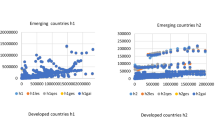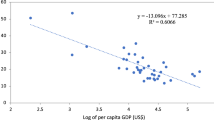Abstract
Within this paper different demand systems are compared by means of test criteria for nested and nonnested hypotheses as well as by some information criteria like the Akaike and Schwatz information criterion.
The analysis includes the Nonseparable Generalized Linear Expenditure System (NGLES), different versions of the Translog-Model (LTL), the Almost Ideal Demand System (AIDS) and the Quadratic Expenditure System (QES).
We conclude from our results that nonflexible demand systems like the Linear Expenditure System (LES) and the Homogeneous Translog-System (HTL) are rejected by means of our information criteria as well as by means of likelihood-ratio-tests. There are only minor differences between the LTL, NGLES, GLES and AIDS due to the information criteria and tests of nonnested hypotheses.
Compared to the information criteria tests of nonnested hypotheses for demand systems are computationally burdensome and costly and do not give completely different results.
Probably the empirical data do not provide enough information to discriminate between different flexible demand systems by using preselected significance levels within the tests of nonnested hypotheses. Therefore these test statistics can also be seen as a descriptive measure of model performance.
Similar content being viewed by others
References
Akaike H (1973) Information theory and the extensions of the maximum likelihood principle. In: Retrov BN, Saki F (eds) 2nd International Symposium on Information Theory, Budapest, pp 267–281
Amemiya T (1980) Selection of regressors. International Economic Review 21:331–354
Atkinson AC (1970) A method for discrimination between models. Journal of Royal Statistical Society, Series B:323–344
Barten AP (1969) Maximum likelihood estimation of a complete system of demand equations. European Economic Review 1:7–73
Berndt ER, Darrough MN, Diewert EW (1977) Flexible functional forms and expenditure distributions: an application to Canadian consumer demand functions. International Economic Review 18:651–675
Blundell R, Ray R (1984) Testing for linear Engel curves and additively separable preferences using a new flexible demand system. The Economic Journal 94:800–811
Christensen LR, Jorgenson DW, Lau LJ (1975) Transcendental logarithmic utility functions. American Economic Review 65:367–383
Cox DR (1961) Tests of separate families of hypotheses, Proceedings of the fourth Berkeley Symposium on Mathematical Statistics and Probability 1, University of California Press, Berkeley California, pp 105–123
Cox DR (1962) Further results on tests of separate hypotheses. Journal of Royal Statistical Society, Series B 24:406–424
Davidson R, MacKinnon JG (1981) Several tests for model specification in the presence of alternative hypotheses. Econometrica 49:781–793
Davidson R, MacKinnon J (1982) Some non-nested hypothesis and the relations among themReview of Economic Studies 49:551–565
Davidson R, MacKinnon J (1983) Testing the specification of multivariate models in the presence of alternative hypotheses. Journal of Econometrics 23:301–313
Deaton A, Muellbauer J (1980) An almost ideal demand system. The American Economic Review 70:312–326
Godfrey LG (1984) On the uses of misspecification checks and tests of non-nested hypotheses in empirical econometrics. Econometric Journal 0:69–81
Hansen G (1984) Der Einfluß von Zinsen und Preisen auf die Ersparnis und die Nachfrage nach dauerhaften Gütern in der Bundesrepublik 1961–1981. Zeitschrift für Wirtschafts- und Sozialwissenschaften 104:227–249
Hansen G (1987) Multikollinearität und Prognosefehler. Jahrbücher für Nationalökonomie und Statistik 203:517–531
Howe H, Pollak RA, Wales TJ (1979) Theory and time series estimation of the quadratic expenditure system. Econometrica 47:1231–1247
Judge GG, Griffiths WE, Hill RC, Lütkepohl H, Lee T-Ch (1985) The theory and practice of econometrics. New York
Lau LJ, Mitchell BM (1971) A linear logarithmic expenditure system: an application to U.S. data. Econometrica 39:87–88
Mizon GE, Richard JF (1983) The encompassing principle and its application to testing non-nested hypotheses. Working Paper, April 1983, University of Southampton
Pesaran MH (1974) On the general problem of model selection. Review of Economic Studies 41: 153–171
Pesaran MH, Deaton AS (1978) Testing non-nested non-linear regression models. Econometrica 46:677–694
Pollak RA, Wales TJ (1978) Estimation of complete demand systems from household budget data: the linear and quadratic expenditure systems. American Economic Review 68:348–359
Quandt RE (1974) A comparison of methods for testing non-nested hypotheses. Review of Economics and Statistics 0:29–99
Sawa RV (1978) Information criteria for discriminating among alternative regression models. Econometrica 46:1273–1291
Sienknecht H-P (1986) Probleme der Konstruktion und Überprüfung ökonometrischer Modelle der Konsumgüternachfrage. Frankfurt a.M.
Statistisches Bundesamt (1982) Volkswirtschaftliche Gesamtrechnungen. Fachserie 18, Reihe S. 5, Revidierte Ergebnisse 1960–1981
Teräsvirta T, Mellin I (1986) Model selection criteria and model selection tests in regression models. Scandinavian Journal of Statistics, Theory and Applications 13:159–171
Theil H (1965) The information approach to demand analysis. Econometrica 0:67–87
Author information
Authors and Affiliations
Additional information
Financial support by the “Deutsche Forschungsgemeinschaft” is gratefully mentioned. We are indebted to two anonymous referees for helpful criticism of an earlier version.
Rights and permissions
About this article
Cite this article
Hansen, G., Sienknecht, H.P. A comparison of demand systems a case study for West-Germany. Empirical Economics 14, 43–61 (1989). https://doi.org/10.1007/BF01980535
Received:
Revised:
Issue Date:
DOI: https://doi.org/10.1007/BF01980535




